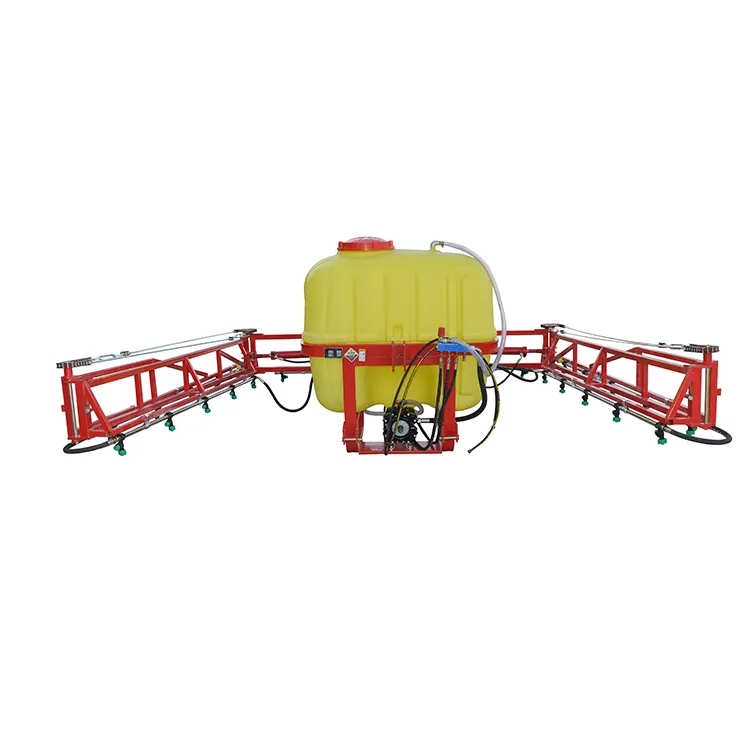Choosing the Right Agricultural Boom Sprayer: A Guide to Features, Types, and Best Practices
2024-11-12
Selecting the right boom sprayer is crucial for farmers looking to improve application efficiency and precision in crop management. This comprehensive guide will cover the essential features to consider, various types of boom sprayers, and best practices for maximizing the effectiveness of this valuable agricultural tool.
Key Points to Cover:
1. Understanding the Core Components of Boom Sprayers
- The Spray Boom: Describe the structure and purpose of the boom, which holds nozzles in place to ensure even chemical distribution. Highlight adjustable booms that allow farmers to modify the spray width based on the size and shape of the field.
- Nozzle Types: Explain the various nozzle options (e.g., flat-fan, hollow-cone, and air-induction) and how different nozzle types influence droplet size, spray pattern, and application accuracy.
- Tank Capacity and Pump Mechanism: Discuss the importance of selecting an appropriate tank size for the farm’s needs and consider pumps (e.g., diaphragm vs. centrifugal) that are capable of handling the desired flow rates and pressures.
2. Different Types of Boom Sprayers and Their Suitability
- Tractor-Mounted Boom Sprayers: Explain that tractor-mounted sprayers are ideal for large farms with open fields, providing excellent coverage and allowing farmers to maximize efficiency on expansive lands.
- Self-Propelled Boom Sprayers: Detail the benefits of self-propelled sprayers, which combine mobility and high capacity, making them ideal for large-scale farming operations where independence from other machinery is valuable.
- ATV-Mounted and Compact Sprayers: Discuss the advantages of compact, ATV-mounted boom sprayers for smaller farms, orchards, or irregularly shaped plots that require greater maneuverability.
3. Factors to Consider When Choosing a Boom Sprayer
- Field Size and Terrain: Describe how the size and terrain of the land affect the choice of sprayer. Hilly or uneven terrain may benefit from self-propelled sprayers with excellent stability, while flat fields may suit larger tractor-mounted units.
- Chemical Application Needs: Explain how different crops may require specific application rates and nozzle types, impacting the type of sprayer chosen. For example, delicate crops may need finer spray to avoid damage.
- Spray Boom Width and Reach: Discuss how wider booms can cover larger areas quickly, but may not be practical for smaller or irregular plots where narrower booms offer better control.
4. Best Practices for Using Boom Sprayers Effectively
- Calibration and Settings: Emphasize the importance of proper calibration to ensure the sprayer applies chemicals accurately and uniformly. Provide guidelines for adjusting spray pressure, nozzle height, and travel speed to achieve the desired coverage.
- Correct Nozzle Spacing and Angle: Advise on proper nozzle spacing to ensure overlapping spray patterns and avoid gaps or overlaps that could affect crop health and chemical efficacy.
- Timing Applications for Optimal Results: Suggest best times for spraying, such as early morning or late evening, to minimize evaporation and ensure chemicals adhere effectively to plant surfaces.
5. Environmental and Safety Considerations
- Minimizing Drift: Describe techniques to reduce chemical drift, including choosing the right nozzle type and angle, setting proper spray pressure, and monitoring wind speed before and during application.
- Safe Chemical Handling and Disposal: Emphasize the importance of safe handling of pesticides, herbicides, and fertilizers, and provide guidelines on proper disposal of any residual chemicals to protect water sources and local ecosystems.
- Personal Protective Equipment (PPE): Recommend appropriate PPE for operators, including gloves, goggles, and masks, to ensure safety while handling chemicals.
6. Maintenance Tips for Long-Term Use and Reliability of Agricultural Boom Sprayers
- Daily and Seasonal Maintenance: Provide tips for daily cleaning and inspection to prevent clogs or leaks. Seasonal maintenance should include thorough system flushing, lubrication, and storage recommendations.
- Nozzle Inspection and Replacement: Discuss the importance of checking nozzles for wear or clogging, which can affect spray patterns and lead to uneven application. Regular nozzle replacement can enhance sprayer performance and prolong equipment life.
- Troubleshooting Common Issues: Address common issues, such as uneven spray patterns or leaks, and offer troubleshooting advice to resolve these problems quickly and efficiently.
Agricultural boom sprayers are indispensable for large-scale, efficient chemical application in crop management. By choosing the right sprayer, following best practices, and keeping up with maintenance, farmers can optimize the benefits of their equipment, improve crop health, and promote sustainable farming practices.



